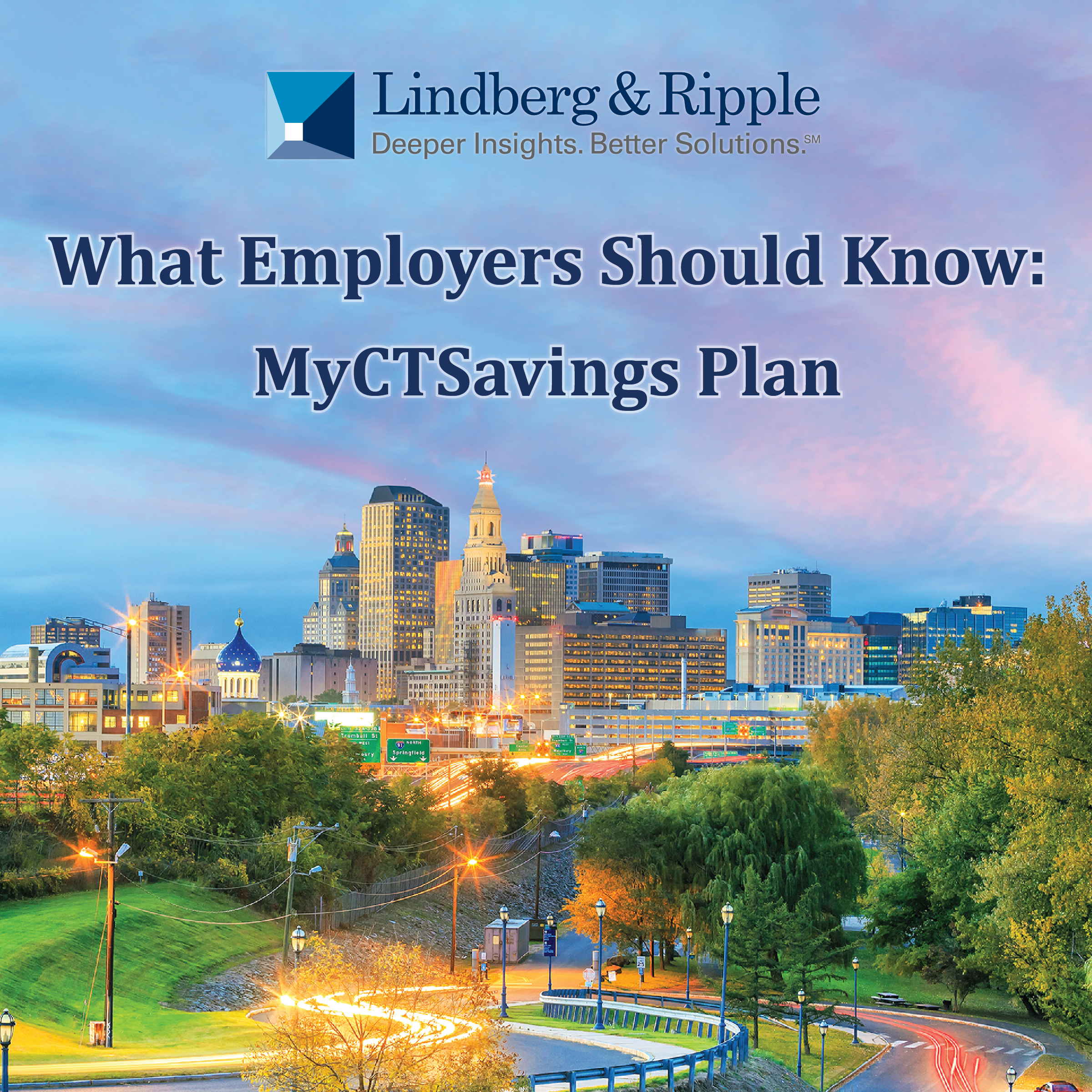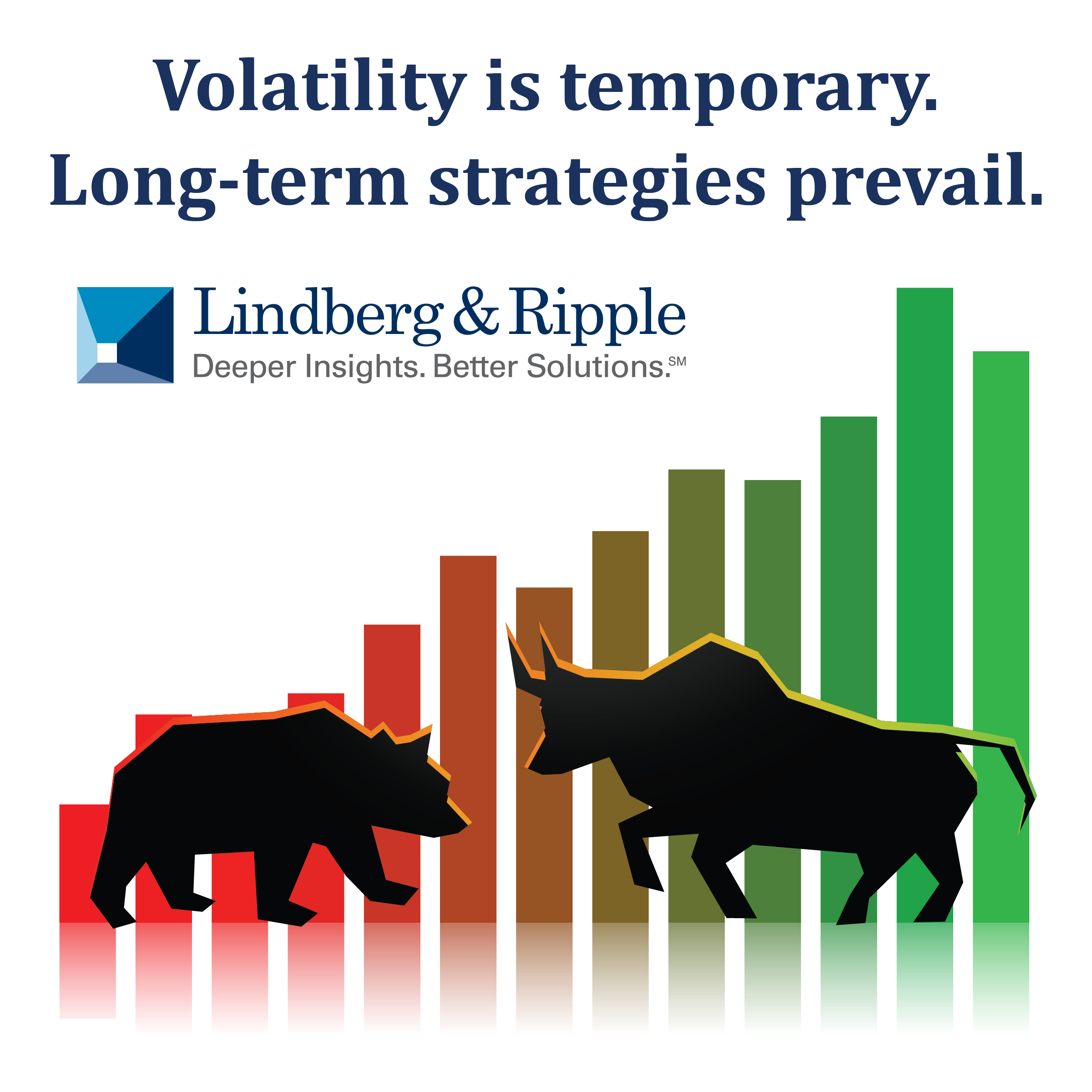The final quarter of the year offers an important opportunity to strengthen your financial position before the calendar resets. Proactive year-end planning…


The final quarter of the year offers an important opportunity to strengthen your financial position before the calendar resets. Proactive year-end planning…

Private equity consolidation in healthcare is accelerating. For many medical and dental professionals, this wave of acquisitions represents both opportunity and risk.

In an age when nearly every financial transaction, document, and communication occurs online, cybersecurity has become a central component of wealth preservation.

On July 4, 2025, the One Big Beautiful Bill Act became law. This wide‑ranging legislation affects taxes, deductions, credits, and other provisions that may have a direct impact on your financial strategy.
At Lindberg & Ripple, we have seen how shifts in tax law can create both opportunities and challenges. While headlines often focus on a few high‑profile changes, the details matter—particularly for individuals and families with significant assets or complex planning needs. In this overview, we highlight fifteen notable provisions and share perspective on what they may mean for your financial plan.
The individual income tax brackets established under the 2017 Tax Cuts and Jobs Act will now remain in place beyond 2026. This certainty allows for longer‑term tax planning. However, the permanence of these lower brackets may also shift strategies around income recognition, Roth conversions, and charitable giving.
From 2025 through 2029, households with income under $500,000 will see the cap on state and local tax (SALT) deductions rise from $10,000 to $40,000. In 2030, the cap returns to $10,000. This creates a five‑year window in which to consider “bunching” deductions or adjusting the timing of state tax payments and charitable contributions to maximize benefits.
Workers below certain income thresholds may deduct a portion of tip and overtime earnings. While this change will primarily help wage earners, it may also influence hiring and payroll structures for business owners in hospitality and service industries.
Interest paid on loans for qualifying U.S.‑assembled vehicles will now be deductible, subject to income limits and annual caps. This may be worth considering when evaluating the cost of vehicle purchases or fleet replacements.
Taxpayers aged 65 or older with income below certain limits may qualify for a deduction of up to $6,000. For some, this may offset taxes owed on Social Security benefits or other income streams.
The maximum child tax credit increases from $2,000 to $2,200 per child, with future adjustments for inflation. While the refundable portion remains the same, this still represents a modest but meaningful benefit for families with dependent children.
Children born between 2025 and 2028 will automatically receive a $1,000 deposit into a new tax‑advantaged account, with parents able to contribute up to $5,000 annually. The funds can grow tax‑deferred, creating an early start on long‑term savings.
Several clean energy tax incentives will be phased out, including credits for electric vehicle purchases. For households or businesses considering these investments, acting sooner may allow for greater tax savings before the incentives disappear.
Beginning in 2026, the estate, gift, and generation‑skipping transfer tax exemption will increase to $15 million per individual ($30 million for married couples), indexed for inflation. This may present a significant opportunity for additional lifetime gifting, funding of trusts, or restructuring of estate plans to transfer wealth more efficiently.
Large university endowments will now be subject to a graduated tax based on the value of assets per student. While this may not affect most individuals directly, it could influence giving strategies for donors who support higher education.
Recipients of Medicaid and Supplemental Nutrition Assistance Program (SNAP) benefits will be subject to new work requirements. States will also be responsible for meeting certain administrative standards.
Retroactive Medicaid coverage will be reduced to two months for traditional recipients and one month for expansion recipients, beginning in 2027. This change may have implications for elder care planning, particularly when it comes to the timing of asset transfers and medical expenses.
The bill raises the federal debt ceiling and includes funding for border security, defense initiatives, and energy development projects.
Additional resources have been allocated to defense systems, the Coast Guard, and public land initiatives. While not directly affecting tax policy, these provisions are part of the broader fiscal context.
The Act introduces new fees for asylum applications, employment authorizations, and certain visa categories, which may affect employers who hire foreign talent.
The provisions in this bill offer both opportunities to enhance your plan and risks that should be addressed proactively.
Maximizing near‑term opportunities
Preparing for phase‑outs
Integrating with long‑term strategy
At Lindberg & Ripple, we have guided clients through many legislative changes. The passage of the One Big Beautiful Bill Act is another reminder that proactive, informed planning can help turn change into opportunity. Every household and business will experience these provisions differently, depending on income levels, assets, goals, and timelines.
Our role is to help you understand the implications in the context of your broader financial picture, and to ensure that your plan remains aligned with both current law and your long‑term vision.
If you would like to explore how these changes may affect your strategy, we invite you to connect with us. Together, we can evaluate your options and determine the best path forward.
File #4742716

Advancements in healthcare, nutrition, and medical technology have made it increasingly common for individuals to live well into their 90s—and beyond. As life expectancy rises, so do the financial implications of a longer retirement. Planning for a 100-year life is no longer a fringe concept. It is becoming the new reality for families who want to ensure lasting financial security, protect their independence, and support future generations.
A longer lifespan can be a tremendous gift, but it also presents unique challenges that require thoughtful planning. Income must last longer. Healthcare costs may escalate. Investment strategies must adapt to changing risk profiles. And in many cases, financial plans must support both aging parents and adult children. Below are several strategies that can help individuals and families prepare for the opportunities and complexities of extended longevity.
Traditional retirement models often assume a time horizon of 20 to 30 years. In a 100-year life scenario, retirement could last 35 to 40 years or more. This longer timeline requires careful calibration of spending, withdrawals, and portfolio sustainability.
One of the most effective approaches is to implement a flexible distribution strategy—one that adjusts spending based on market performance, inflation, and evolving lifestyle needs. Advisors often use modeling tools to simulate a range of outcomes and identify safe withdrawal rates that preserve capital throughout a multi-decade retirement.
Longevity increases the likelihood of requiring some form of long-term care. According to the U.S. Department of Health and Human Services, nearly 70% of individuals turning age 65 today will need long-term care services at some point in their lives. These costs can be substantial and may quickly deplete even a well-constructed retirement portfolio.
Long-term care insurance is one planning tool that can help mitigate this risk. Policies may cover expenses such as assisted living, in-home care, and nursing facility stays—services often not covered by Medicare. Hybrid policies that combine life insurance or annuity features with long-term care benefits are also growing in popularity, offering flexibility and potential for unused benefits to pass to heirs.
For those concerned about outliving their assets, annuities can provide a valuable source of guaranteed income. By converting a portion of retirement savings into a lifetime income stream, annuities can create financial stability and reduce pressure on investment portfolios during market downturns.
Different types of annuities—such as deferred income annuities or immediate fixed annuities—can be tailored to fit specific timelines, needs, and risk tolerances. While annuities are not suitable for every investor, they can play a strategic role in covering essential expenses, particularly in the later stages of retirement.
A longer retirement horizon may require maintaining equity exposure later in life. The traditional glide path that gradually shifts toward fixed income may no longer be sufficient to sustain returns over 30 or 40 years. Instead, portfolios must balance the need for growth with appropriate risk management.
This does not mean taking unnecessary risks. It means aligning asset allocation with time horizon, cash flow needs, and risk tolerance. Diversification, rebalancing, and tax-efficient withdrawals remain essential components of long-term portfolio management.
Longevity often coincides with multigenerational financial responsibilities. Clients may find themselves supporting elderly parents, assisting adult children, or helping grandchildren with education. Coordinating these priorities requires open communication and a well-structured financial plan.
Wealth transfer strategies, gifting programs, and trust structures can support intergenerational goals while preserving long-term financial independence. Involving family members in financial conversations can also create opportunities for education, stewardship, and shared decision-making.
Planning for a 100-year life is not just about living longer—it is about living well. It requires proactive strategies that adapt to changing needs, protect against unexpected risks, and ensure that wealth serves both present and future generations.
At Lindberg & Ripple, we work closely with clients to build flexible, resilient financial plans designed to support a longer, healthier life. Through customized income strategies, healthcare planning, and multigenerational coordination, we help clients prepare for the future with confidence and clarity.
File # 4610582

For many high-net-worth individuals and families, wealth planning tends to focus on asset growth, tax efficiency, and legacy creation. While these elements are essential, there is another equally critical area that often goes overlooked: incapacity planning. The reality is that cognitive decline, medical emergencies, or unexpected accidents can affect anyone at any time. Without a proactive plan in place, the consequences can be financially and emotionally devastating for both individuals and their families.
As clients age, manage complex portfolios, or acquire global assets, the need to safeguard decision-making authority becomes even more urgent. Incapacity planning is not simply a matter of legal documentation. It is a strategic imperative that protects family dynamics, ensures continuity, and preserves the intent behind a lifetime of careful planning.
Incapacity risk increases with age, but it does not exclusively affect older individuals. Illness, injury, or travel-related emergencies can temporarily or permanently impair one’s ability to make financial or medical decisions. When no plan exists, loved ones may face costly delays, legal complications, or even court-appointed guardianship.
For individuals with significant wealth, these risks are amplified. Complex investment strategies, family trusts, operating businesses, and cross-border holdings require sophisticated oversight. Without clear instructions and empowered agents, critical matters may be mishandled—or worse, left in limbo.
A durable power of attorney (POA) allows a trusted individual to act on your behalf in managing financial affairs if you become incapacitated. This can include paying bills, managing investments, filing taxes, or handling real estate transactions. The document must be tailored to your specific holdings and reviewed periodically to reflect changes in your financial life.
Without a POA, no one—not even a spouse—automatically has the authority to make financial decisions on your behalf. In such cases, family members must petition the court to become your legal guardian or conservator—a process that can be time-consuming, public, and emotionally taxing.
A healthcare proxy designates someone to make medical decisions if you are unable to do so. When combined with an advance directive (also known as a living will), it allows you to communicate your preferences regarding life-sustaining treatments, palliative care, and organ donation.
These documents are essential for preserving your dignity, avoiding unnecessary interventions, and relieving loved ones from making painful decisions without guidance. In situations involving cross-border living or international travel, having valid and portable healthcare directives is even more important.
Revocable living trusts can serve as a powerful incapacity planning tool. Unlike wills, which become effective only after death, a living trust can manage assets during your lifetime and in the event of incapacity. The successor trustee—typically a family member, advisor, or professional fiduciary—can step in immediately to ensure bills are paid, investments are managed, and wealth continues to be stewarded according to your wishes.
Trusts are especially valuable for individuals with assets in multiple jurisdictions, business interests, or blended family dynamics. They help prevent court interference and provide clear guidance during challenging periods.
Modern wealth often includes digital assets: online bank accounts, cloud-stored documents, investment portals, and communication platforms. If key individuals cannot access these tools, even the most carefully designed plan may falter.
Incapacity planning should include a secure and legally compliant method for sharing credentials, access instructions, and digital asset inventories. This step ensures that trustees, agents, or family members can act swiftly and confidently when needed.
Incapacity planning is not merely a contingency—it is a core component of any comprehensive wealth strategy. It protects your financial legacy, preserves family harmony, and ensures that your intentions remain in place, even if you are unable to express them.
It is also an opportunity to engage in multigenerational planning. By involving family members in the process, you can foster transparency, set expectations, and empower the next generation to manage responsibilities with clarity and confidence.
The possibility of incapacity is uncomfortable to consider, but failing to plan for it is a far greater risk. At Lindberg & Ripple, we help clients build thoughtful, integrated plans that include the essential safeguards needed to maintain control and protect what matters most.
We encourage every client—regardless of age or wealth level—to treat incapacity planning as an essential element of their financial life. Because comfort is not just about what happens when you are gone. It is also about knowing your affairs are in order if life takes an unexpected turn.
File # 4610631

Charitable giving has always been a powerful expression of personal values, community support, and family legacy. Today, affluent families and business owners are seeking more strategic ways to give—methods that align with long-term financial goals while creating meaningful impact. Fortunately, modern philanthropic tools allow donors to structure their giving with precision, flexibility, and tax efficiency.
Whether you wish to establish a lasting legacy, involve your children in philanthropic decisions, or simply reduce your taxable estate, a structured giving strategy can serve as a cornerstone of your financial plan. Below are several effective vehicles that can help increase the benefits of giving—both to the causes you care about and to your family’s financial future.
A donor-advised fund (DAF) allows individuals to make a charitable contribution, receive an immediate tax deduction, and then recommend grants to their chosen nonprofits over time. These funds are often administered by public charities or financial institutions and have grown in popularity due to their simplicity and efficiency.
DAFs offer several advantages:
Because DAFs are relatively easy to establish and require no separate tax filings, they are often a first step for families seeking to formalize their philanthropy without the administrative burden of a private foundation.
A charitable remainder trust (CRT) is a tax-exempt irrevocable trust that allows you to convert highly appreciated assets—such as stocks or real estate—into a lifetime income stream, while ultimately benefiting a charitable cause.
Here is how it works:
CRTs can be powerful tools for donors who wish to reduce concentrated positions, diversify their portfolios, and support a meaningful cause—all while securing a source of retirement income.
For families with significant charitable assets and a desire for long-term legacy-building, a private foundation may be the ideal solution. A private foundation is a separate legal entity, typically funded by an individual, family, or corporation, and managed by a board of directors or trustees.
Advantages of a private foundation include:
However, private foundations come with greater complexity. They require annual tax filings, a minimum distribution requirement, and strict adherence to self-dealing rules. Families should work closely with legal and tax advisors to ensure proper administration and compliance.
Effective charitable giving is about more than reducing taxes—it is about defining and passing on your values. Integrating philanthropy into your legacy plan can help unify family members around shared causes and foster conversations about responsibility, generosity, and long-term purpose.
Structured giving vehicles can be designed to support multi-generational involvement. For example, a DAF or foundation can be co-managed by children and grandchildren, offering them an opportunity to participate in thoughtful decision-making. Charitable trusts can be tailored to provide lifetime income to a surviving spouse before passing the remainder to charity.
These strategies not only enhance the impact of your giving but also ensure that your legacy continues to reflect your ideals for generations to come.
Philanthropy can be one of the most rewarding aspects of wealth stewardship. With the right tools, it is possible to give generously, reduce taxes, and reinforce the values that matter most to you and your family.
At Lindberg & Ripple, we help clients align their charitable goals with their financial strategies. Whether you are exploring a donor-advised fund, establishing a private foundation, or integrating philanthropy into your estate plan, our team is here to help you make your giving more purposeful and impactful.
File # 4610490

Did you know that Connecticut businesses could face fines of up to $1,500 per employee for not complying with the state’s retirement mandate? In fact, if you have five or more employees and do not offer a retirement plan, you are required to register for MyCTSavings or certify your exemption.
MyCTSavings is designed to make it easier for employees to save for retirement—especially those who do not currently have access to a workplace retirement plan. At Lindberg & Ripple, we work with business owners and leadership teams across the state who are navigating this new requirement. Whether you already offer a plan or are still evaluating your options, here is a quick overview of what the law requires, how the program works, and how we can help.
Today, nearly 600,000 workers in Connecticut do not have access to a retirement plan through their employer. That number is part of a much larger national trend—roughly half of all workers in the private sector face the same challenge.
In response, states like Connecticut have begun to roll out retirement programs that aim to close the gap and encourage long-term saving.
MyCTSavings applies to businesses that meet all three of the following:
If your business qualifies, you are required to register for MyCTSavings or certify that you already offer a plan.
The program is built around simplicity—for both employers and employees. Here is how it functions:
If your business already offers a qualified plan, you may be exempt. Here are the types of plans that meet the state’s criteria:
You will still need to certify your exemption using the state’s portal and a unique access code.
Connecticut has made it clear: businesses that ignore the requirement may face financial penalties. Fines can range from $500 to $1,500 per employee, depending on the size of your company and how long you have been out of compliance.
While the mandate may feel like another item on your compliance list, it also presents a moment to evaluate whether your current benefits plan is working as hard as it could be. Offering a more robust, privately managed retirement solution may not only satisfy the requirement—but also help attract and retain top talent.
At Lindberg & Ripple, we help clients weigh the options, structure their retirement plans, and stay ahead of changing regulations. Whether you need to certify your exemption, consider implementing a new plan, or simply want a second opinion, we are here to help.
We understand that no two businesses are alike. Our team can help you:
If you would like to have a conversation about MyCTSavings—or explore better ways to serve your employees—we welcome the opportunity to talk.
File#4670284

The rise of artificial intelligence (AI) has transformed nearly every sector of the global economy, and wealth management is no exception. From robo-advisors to AI-driven portfolio optimizers and tax-loss harvesting tools, technology has become a powerful force in financial planning and investing. These tools offer speed, efficiency, and the ability to analyze vast amounts of data in real time. Yet, as impressive as these capabilities are, they do not replace the experience, context, and strategic thinking that a seasoned advisor brings to the table.
AI has enabled platforms to automate many aspects of investment management. Retail investors can now access low-cost digital advisors that build and rebalance portfolios with little human intervention. Sophisticated algorithms analyze risk tolerance, income levels, time horizons, and even behavioral tendencies to offer personalized asset allocations.
For more advanced investors, AI-driven platforms can identify tax-loss harvesting opportunities in real time, optimize the timing of trades, and detect market anomalies that may influence asset prices. These features bring notable advantages in scale, consistency, and cost-effectiveness.
Despite growing interest in AI, most experienced financial advisors are taking a measured approach to its integration. While some firms are experimenting with AI tools to streamline back-office functions—such as document processing, compliance review, and client onboarding—very few are placing client relationships or investment decision-making entirely in the hands of algorithms.
Advisors are beginning to use AI selectively to support financial planning. For example, scenario modeling tools are increasingly AI-enabled, allowing advisors to simulate multiple variables around retirement income, tax strategies, or charitable giving. In this context, AI enhances the planning process—but only as a starting point. Advisors still interpret the results, evaluate trade-offs, and incorporate the human factors that the software cannot see.
There is also growing awareness of AI’s limitations. Many advisors remain skeptical of relying on “black-box” models that produce recommendations without transparency. In a highly personalized business that relies on trust, clients expect clarity—something that machine-generated outputs do not always provide.
Despite these innovations, algorithms operate within the boundaries of their programming. They lack the ability to fully understand complex personal and emotional dynamics that often influence financial decisions. A well-designed algorithm can suggest rebalancing a portfolio, but it cannot evaluate whether a client is preparing to fund a child’s education, transition a business, or navigate a challenging family situation.
Moreover, AI tools are only as effective as the data and assumptions that underpin them. During periods of market disruption, human investors often act in unpredictable ways. Advisors with deep experience and perspective can guide clients through those moments—explaining the why behind volatility, identifying overlooked opportunities, and recommending course corrections when appropriate.
Human advisors offer a level of nuance that no algorithm can replicate. They understand the long-term goals and deeply personal motivations that drive financial decisions. They can ask questions a computer will not—questions about values, legacy, and priorities. These insights inform customized strategies that evolve as life circumstances change.
Additionally, advisors can offer emotional steadiness when markets are turbulent. During moments of uncertainty, clients often benefit most from reassurance, clarity, and a steady voice—qualities that build trust over time and cannot be coded into software.
AI is not a replacement for human judgment—it is a complement. At its best, technology enhances an advisor’s ability to serve clients more effectively. It enables more robust modeling, faster scenario analysis, and streamlined administrative tasks. This allows advisors to spend more time on what matters most: understanding clients, crafting personalized strategies, and helping families stay the course toward their long-term goals.
AI will continue to reshape wealth management in powerful ways. However, financial success rarely depends on efficiency alone. It depends on making thoughtful, informed decisions over decades. That is where human insight—grounded in experience, empathy, and trust—continues to shine.
At Lindberg & Ripple, we embrace technology, but never at the expense of human connection. Our mission remains the same: to provide clarity, confidence, and personalized guidance through every phase of your financial journey.
File # 4610427

Geopolitical conflict is unsettling. It can trigger fear, dominate headlines, and cause sudden drops in the market. Investors understandably worry about what war, terrorism, or political instability may mean for their portfolios. However, history offers a clear and consistent lesson: while markets may react sharply in the short term, they have shown remarkable resilience over time.
Understanding how markets have responded to past conflicts can help investors maintain perspective and remain committed to long-term strategies—even when the news is anything but calm.
The Cuban Missile Crisis brought the world to the brink of nuclear war. Tensions between the United States and the Soviet Union escalated rapidly, and investors responded with anxiety. Between mid-September and late October 1962, the S&P 500 declined approximately 6%. However, by the end of the year, the market had not only recovered—it had gained more than 10% from its pre-crisis levels.
Takeaway: Even during moments of extreme geopolitical tension, the market’s long-term trajectory can remain intact.
When Iraq invaded Kuwait in August 1990, oil prices spiked and global markets sold off. Between July and October 1990, the S&P 500 fell more than 15%. But after the U.S.-led coalition launched Operation Desert Storm in January 1991, the markets rebounded quickly. By the end of 1991, the S&P 500 had risen over 26% for the year.
Takeaway: Markets tend to recover strongly after the uncertainty surrounding a conflict begins to subside, particularly when outcomes appear more predictable.
Following the attacks of September 11, the U.S. stock markets closed for four days. When they reopened, the S&P 500 dropped nearly 5% in a single day and declined about 11.6% for the week. However, within a month, markets began to stabilize. One year later, the S&P 500 had essentially returned to its pre-attack levels.
Takeaway: Even in the face of unprecedented tragedy, markets proved capable of rebounding once panic gave way to resilience.
The extended conflict in Afghanistan spanned two decades, yet over that same period, equity markets posted significant gains. From October 2001 to October 2021, the S&P 500 grew by more than 300%, despite ongoing military operations and frequent geopolitical instability.
Takeaway: Long-term investors who remained committed to their strategies experienced substantial growth, even during protracted conflicts.
Geopolitical events can create real economic disruptions—rising energy prices, supply chain interruptions, and market volatility. But history shows that these disruptions tend to be temporary, and that markets often recover more quickly than expected.
Emotional decisions during volatile periods—such as moving to cash or abandoning a diversified portfolio—can lock in losses and prevent investors from participating in the recovery. A disciplined, long-term approach can help investors stay focused on their goals, rather than reacting to short-term noise.
Long-term investing is grounded in several core principles:
Conflict is an unfortunate reality in the world. But time and again, markets have demonstrated their ability to weather even the most challenging global events. Investors who remain focused on long-term fundamentals, rather than short-term fear, tend to be rewarded with greater stability and better outcomes.
At Lindberg & Ripple, we help clients stay grounded during uncertainty by building investment strategies designed for resilience. We understand that global headlines can be unsettling, but with the right plan in place, investors can move forward with confidence—regardless of the storm.
CA Insurance License # 390636 File # 4610466